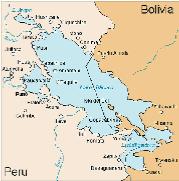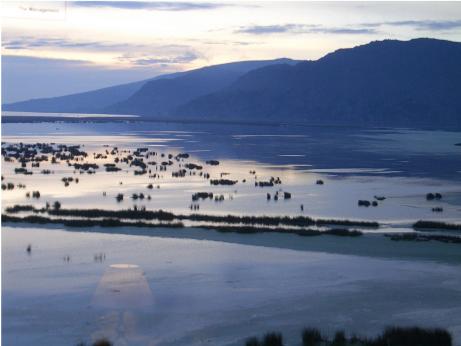From Cusco, we flew to Juliaca which is the closest airport to Puno. Our actual destination was Lake Titicaca however, Puno is the town on the lake.
To the right is a view of the lake from our room. Below is the view from the front of the hotel.
Our first destination on Lake Titicaca was the floating islands of Uros. The floating islands are made of reeds. So are the boats, the huts, the cooking areas, and in fact everything.
On the left is the inside of one of the huts. Some of the huts have electricity provided by solar panels. We also saw this later on the island of Taquile.
On the right is a lady cleaning and preparing potatoes.
Granny is getting a hug from our guide, Mario, before getting in the boat for our ride to another reed island. Granny and Grandpa are now ready for the trip. All we need is our crew. The boat is propelled by a single person using an oar. Below left is a picture of our crew doing his thing. On the right is a little island girl that came along for the ride.
On the left is a woman cooking some empanadas. Notice the cement block that acts as a base for the burner. Wood is used as the fuel for her 2 burner stove.
The reeds are hung to dry and also serve as decoration. You have to imagine how it feels to walk on these reeds. They feel sort of spongy but at the same time solid. It's a very unusual feeling knowing you are walking on a floating island.
The bird on the right is a cormorant. At the moment, its legs are tethered. These birds are used for fishing as they are exceptional fish catchers. I'm not sure how they use them here, but other places they will restrict the bird from swallowing the fish so they can retrieve the fish from the bird. .
Lake Titicaca is the third largest lake in the world and the hightest navigable body of water in the world at an altitude of over 12,500 feet. It is truly an amazing place. The eastern part of the lake belongs to Bolivia. The western part of the lake is in the Puno region of Peru.
Our hotel, the Libertador, is a modern structure situated on the shore of a large bay. Our day long excursion went to the Islands of Uros which are inside the bay and to Taquile island which is just outside the bay.

Next it was on to the island of Taquile.
Taquile sits just outside the bay where our hotel is located. The island is inhabited by about 1700 people and visited each year by about 40,000 tourists. It is known for its weavings which are done primarily by the men. The women spin the yarn and the men do the knitting and weaving.
The main village is almost 1,000 feet higher than the lake. Climbing up 1,000 feet when you're at an altitude of almost 13,000 feet is quite tiring. Our guide took us on the longer, more gradual ascent rather than climbing the steps. We saved the steps for the trip down.
Wherever we went, we saw the women spinning the yarn. They spin as they walk, while they are standing, and while they are sitting. It seems like they never stop. We even had one ride back with us to Puno and she was spinning most of the way. Click here to see her spinning her yarn.
Typical landscape of Taquile
As we climbed the path to the village, we saw terraced farms where they grow primarily potatoes. They also do a lot of fishing from small boats. Although there is no electric utility, they do have solar panels and of course some TV.
What do you do with your old sandals? For a better view, look at the enlarged picture.
We had lunch in the village and then it was time to start our descent down the steps.
About 1/2 way down the steps are some arches which make a nice frame for a picture of the intrepid travelers.
And we thought we had it tough. Look at this woman carrying her supplies up the steps. I tried lifting that load and it was HEAVY!
Looking back up at the arches.
It was time to get back on our boat for the trip back to Puno. Actually these are some of the boats the Taquilenos use for fishing.
Our last day in the Puno region was spent seeing some of the nearby sights and was capped off by a wonderful treat from our fabulous guide.
We drove to the village of Chucuito to see the phallic garden. But is it really a phallic garden? Look at this article from the New York Times. Below are a couple of our pictures of the Inca Uyo.
On the road to Chuquito, we saw some locals making grass mattresses. These mattresses are made from the local reeds and grasses. Click here to see a video of the mattress making process.
Back in Puno, we saw another version of the pedal carts. These are used to transport tourists, locals, goods for sale, or just about anything.
The special treat from our guide was a visit to a costume shop where we were able to try on some of the costumes that are used in their annual festival. Here we are decked out and ready to roll.
